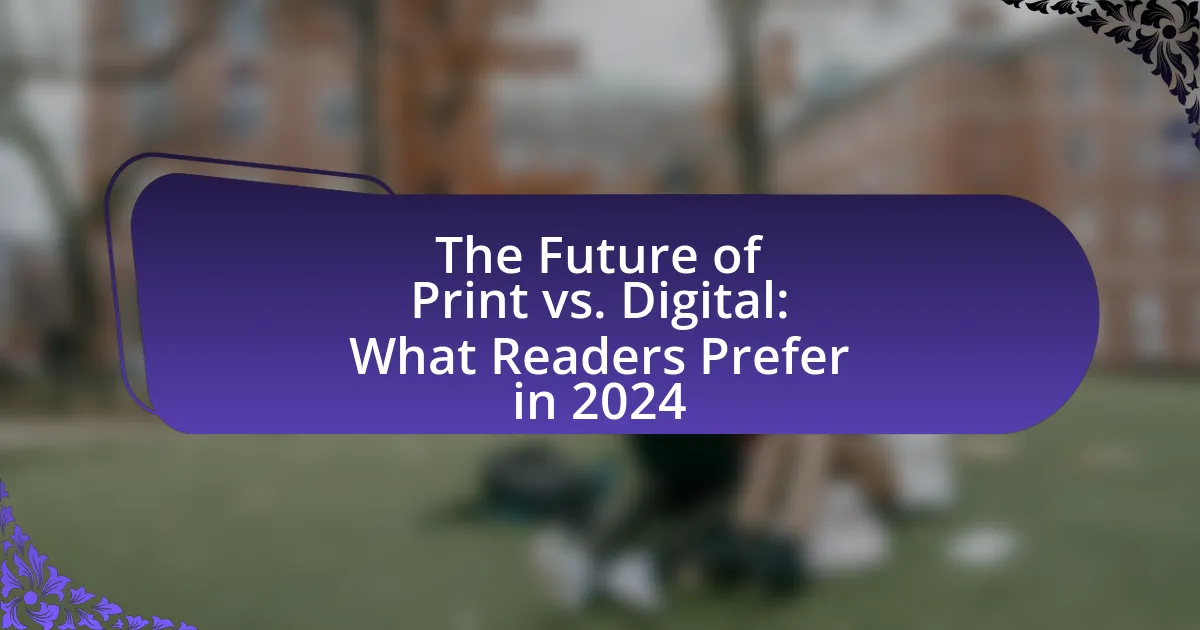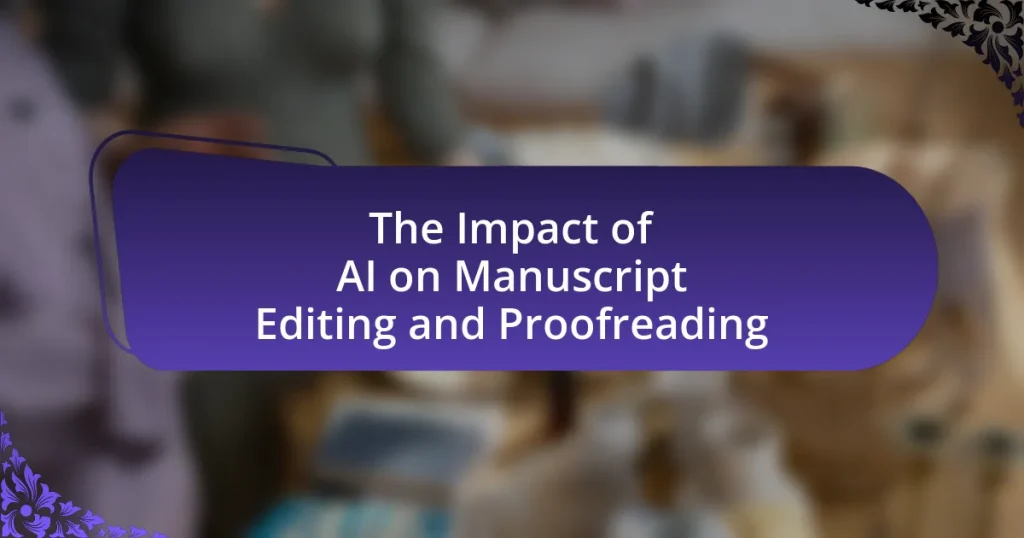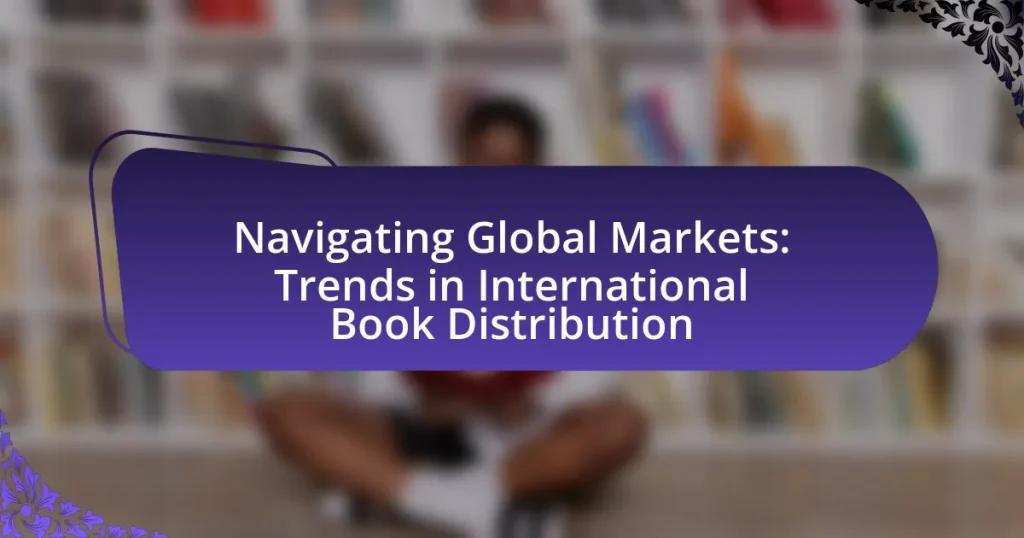The article examines the evolving landscape of print and digital media preferences in 2024, highlighting a notable trend towards hybrid consumption where 60% of consumers engage with both formats. It discusses the shift in reader preferences, with a significant majority favoring digital content for its convenience, while also addressing the enduring appeal of print due to its tactile experience and emotional connections. Key demographic factors influencing these preferences, the impact of accessibility on reader choices, and the role of technology in enhancing user experiences are explored. Additionally, the article outlines the implications for publishers and authors, emphasizing the need for adaptive strategies to cater to diverse audience preferences in both print and digital formats.
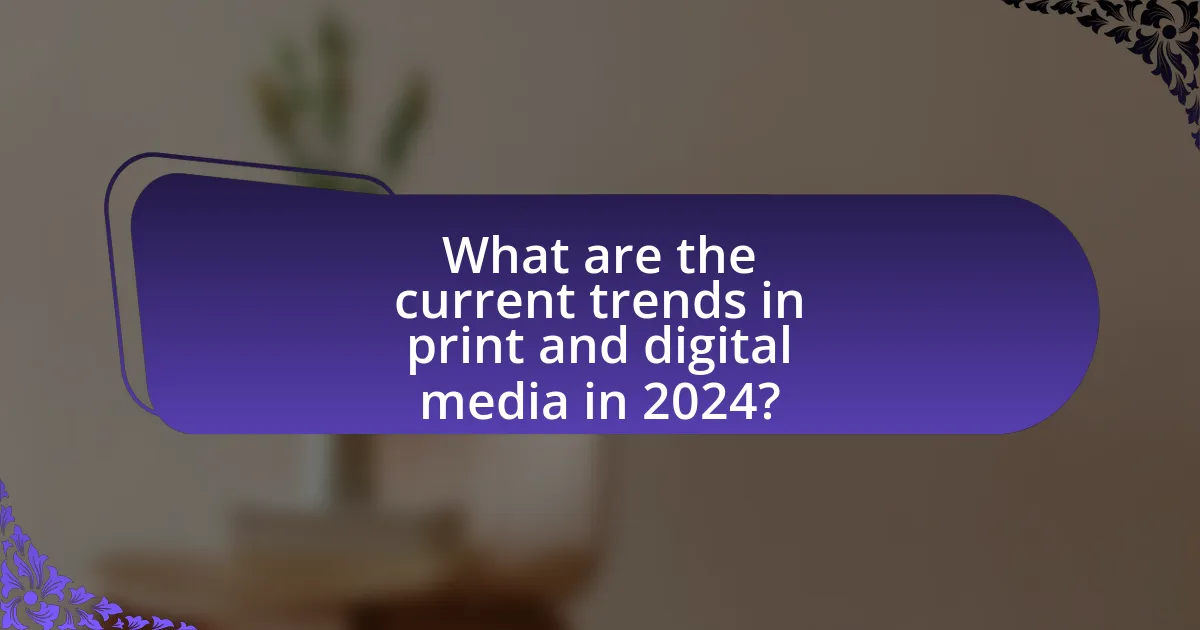
What are the current trends in print and digital media in 2024?
In 2024, the current trends in print and digital media indicate a significant shift towards hybrid consumption, where readers increasingly prefer a combination of both formats. Research shows that 60% of consumers engage with both print and digital media, valuing the tactile experience of print alongside the convenience of digital access. Additionally, sustainability is a growing concern, with 45% of readers favoring eco-friendly print options, while digital platforms are enhancing user experience through interactive content and personalized recommendations. This dual approach reflects a broader trend of adaptability in media consumption, driven by technological advancements and changing consumer preferences.
How are reader preferences shifting between print and digital formats?
Reader preferences are increasingly shifting towards digital formats over print. A 2023 survey by the Pew Research Center found that 65% of adults in the U.S. prefer reading digital content, citing convenience and accessibility as primary reasons. In contrast, only 35% expressed a preference for print, indicating a significant decline in print readership. This trend is further supported by the rise of e-books and audiobooks, which have seen a 30% increase in sales over the past two years, reflecting a broader acceptance of digital media among readers.
What demographic factors influence these preferences?
Demographic factors that influence preferences between print and digital formats include age, education level, income, and geographic location. For instance, younger individuals, particularly those aged 18-34, tend to prefer digital formats due to their familiarity with technology and mobile devices, while older adults often favor print due to its tactile nature and ease of reading. Additionally, higher education levels correlate with a preference for digital content, as educated individuals are more likely to engage with online platforms. Income also plays a role; those with higher incomes may prefer digital subscriptions for convenience, while lower-income groups might lean towards print due to accessibility. Geographic location impacts preferences as well, with urban residents more inclined towards digital formats compared to rural populations, who may have limited internet access and thus prefer print. These trends are supported by research from the Pew Research Center, which highlights the relationship between demographic variables and media consumption habits.
How does accessibility impact reader choices?
Accessibility significantly influences reader choices by determining the ease with which individuals can access and engage with content. When materials are designed with accessibility in mind, such as providing text-to-speech options or ensuring compatibility with screen readers, a broader audience can participate, including those with disabilities. Research indicates that 15% of the global population experiences some form of disability, which underscores the importance of accessible formats in attracting and retaining readers. Consequently, when readers encounter accessible content, they are more likely to choose it over less accessible alternatives, thereby impacting their overall reading preferences and habits.
What role does technology play in shaping reader experiences?
Technology significantly enhances reader experiences by providing interactive and personalized content delivery. Digital platforms enable features such as multimedia integration, allowing readers to engage with text through videos, audio, and interactive graphics, which enriches comprehension and retention. For instance, a study by the Pew Research Center in 2021 found that 79% of readers prefer digital formats for their accessibility and convenience, indicating a shift in reader preferences towards technology-driven experiences. Additionally, algorithms used in digital platforms can tailor content recommendations based on individual reading habits, further enhancing engagement and satisfaction.
How do e-readers and apps enhance digital reading?
E-readers and apps enhance digital reading by providing features that improve accessibility, convenience, and interactivity. These devices allow users to adjust font sizes, background colors, and lighting, making reading more comfortable for individuals with visual impairments or different reading preferences. Additionally, e-readers and apps offer instant access to a vast library of books and articles, enabling readers to download content instantly without the need for physical storage. Research indicates that 65% of readers prefer digital formats for their portability and ease of access, as reported by the Pew Research Center in 2021. Furthermore, interactive features such as built-in dictionaries, note-taking capabilities, and hyperlinks facilitate a more engaging reading experience, allowing readers to explore content in depth.
What innovations are emerging in print media?
Innovations emerging in print media include the integration of augmented reality (AR) and interactive elements, which enhance reader engagement. For instance, publications are increasingly incorporating QR codes and AR features that allow readers to access multimedia content directly from printed pages, bridging the gap between physical and digital experiences. According to a 2023 report by the International News Media Association, 45% of print publications are experimenting with AR to create immersive storytelling experiences, demonstrating a significant shift towards interactive print formats.

Why do some readers still prefer print over digital?
Some readers still prefer print over digital due to the tactile experience and reduced eye strain associated with physical books. Research indicates that 70% of readers find it easier to concentrate on printed material compared to digital formats, as the physicality of a book allows for better retention and comprehension. Additionally, print books do not emit blue light, which can cause fatigue and disrupt sleep patterns, making them a more comfortable option for extended reading sessions.
What emotional connections do readers have with print media?
Readers have strong emotional connections with print media due to its tactile nature and the nostalgia it evokes. The physicality of holding a book or magazine creates a sensory experience that digital formats often lack, fostering a sense of comfort and familiarity. Research indicates that 70% of readers report feeling more engaged with printed materials compared to digital ones, attributing this to the ability to disconnect from screens and immerse themselves in the content. Additionally, print media often symbolizes permanence and authenticity, enhancing the emotional bond readers develop with the material. This connection is further reinforced by the ritualistic aspects of reading print, such as the act of turning pages, which can evoke memories and feelings associated with past reading experiences.
How does the tactile experience of print influence reader satisfaction?
The tactile experience of print significantly enhances reader satisfaction by engaging multiple senses, which digital formats often lack. Research indicates that physical interaction with printed materials, such as the texture of paper and the weight of a book, creates a more immersive reading experience. A study published in the journal “Psychological Science” by Mangen, Walgermo, and Brønnick found that readers of print texts performed better on comprehension tests compared to those reading digitally, suggesting that the tactile feedback from print aids in memory retention and understanding. This sensory engagement fosters a deeper emotional connection to the material, ultimately leading to higher levels of satisfaction among readers.
What nostalgia factors contribute to print preferences?
Nostalgia factors that contribute to print preferences include tactile experiences, emotional connections, and the sensory engagement associated with physical books and printed materials. Research indicates that the tactile sensation of turning pages and the smell of paper evoke memories and feelings of comfort, which enhance the reading experience. A study published in the journal “Psychology of Popular Media” found that individuals often associate print media with positive childhood experiences, reinforcing their preference for physical formats over digital alternatives. Additionally, the permanence of print allows for a sense of ownership and nostalgia that digital formats cannot replicate, further solidifying print’s appeal among readers.
What are the perceived drawbacks of digital reading?
The perceived drawbacks of digital reading include eye strain, reduced retention of information, and distractions from notifications. Eye strain is a common issue due to prolonged screen time, with studies indicating that 50-90% of people using digital devices experience symptoms of digital eye strain. Additionally, research shows that readers often retain less information when reading digitally compared to print, as highlighted in a study published in the International Journal of Educational Research, which found that students performed better on comprehension tests after reading printed materials. Lastly, digital reading is frequently interrupted by notifications and multitasking, which can hinder focus and comprehension, as noted in a report by the Pew Research Center that found 47% of adults feel distracted while reading on digital devices.
How do screen fatigue and distractions affect digital reading habits?
Screen fatigue and distractions significantly diminish digital reading habits by reducing attention span and comprehension. Research indicates that prolonged exposure to screens leads to cognitive overload, making it difficult for readers to focus on content. A study published in the journal “Computers in Human Behavior” found that individuals exposed to digital distractions, such as notifications and multitasking, experienced a 40% decrease in reading comprehension. Furthermore, screen fatigue can result in physical discomfort, leading to shorter reading sessions and a preference for print materials, as readers seek relief from digital strain.
What concerns do readers have regarding digital privacy and data security?
Readers express significant concerns regarding digital privacy and data security, primarily focusing on the unauthorized access to personal information. A survey conducted by Pew Research Center in 2021 revealed that 81% of Americans feel that the potential risks of data collection by companies outweigh the benefits. Additionally, readers worry about data breaches, with 43% of adults reporting that they have experienced a data breach in some form. These concerns are compounded by the increasing prevalence of cyberattacks, which have risen by 50% in the past year, highlighting the urgent need for robust data protection measures.
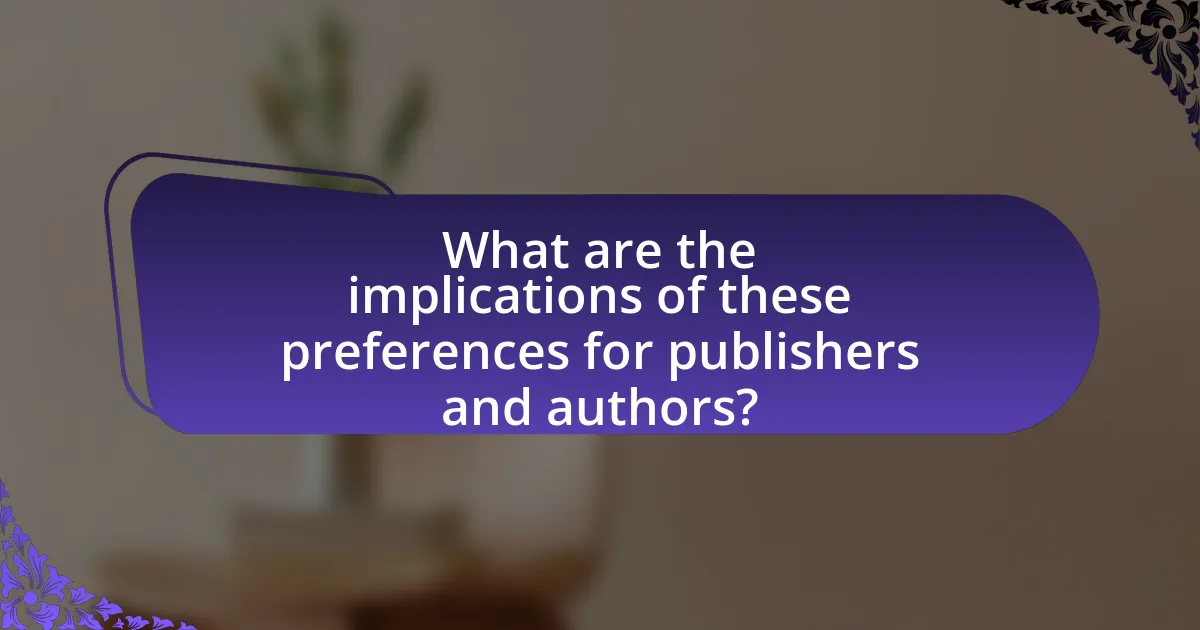
What are the implications of these preferences for publishers and authors?
The implications of reader preferences for publishers and authors include the need to adapt their strategies to meet the growing demand for digital content while still catering to print enthusiasts. As surveys indicate that a significant portion of readers prefer digital formats for convenience and accessibility, publishers must invest in digital platforms and marketing strategies to reach this audience effectively. Additionally, authors may need to consider diversifying their work into digital formats, such as e-books and audiobooks, to maximize their reach and sales potential. The shift towards digital also suggests that traditional print sales may decline, prompting publishers to reassess their print production and distribution models to remain competitive in a rapidly evolving market.
How should publishers adapt their strategies in response to reader preferences?
Publishers should adapt their strategies by incorporating data-driven insights to align content offerings with reader preferences. This involves analyzing reader engagement metrics, such as time spent on articles and feedback through surveys, to identify popular topics and formats. For instance, a 2023 survey by the Pew Research Center indicated that 61% of readers prefer digital formats for their convenience and accessibility, prompting publishers to prioritize digital content creation and distribution. Additionally, publishers should diversify their platforms, utilizing social media and mobile applications to reach audiences where they are most active. By responding to these preferences, publishers can enhance reader satisfaction and retention.
What marketing approaches work best for print versus digital audiences?
Print audiences respond best to tactile, visually appealing materials such as brochures, direct mail, and magazine ads that leverage high-quality imagery and physical engagement. In contrast, digital audiences favor interactive content, targeted social media ads, and email marketing that utilize data analytics for personalization. Research indicates that print marketing can enhance brand recall by 70% compared to digital, while digital marketing allows for real-time engagement and measurable results, making it effective for immediate conversions.
How can content creators balance print and digital offerings?
Content creators can balance print and digital offerings by integrating both formats to cater to diverse audience preferences. Research indicates that 79% of consumers enjoy reading print materials, while 67% prefer digital formats for their convenience (Source: Pew Research Center, 2021). By offering a hybrid model, creators can leverage the tactile experience of print alongside the accessibility of digital content. This approach allows for cross-promotion, where print editions can drive traffic to digital platforms and vice versa, enhancing overall engagement and reach.
What best practices can authors follow to engage readers in both formats?
Authors can engage readers in both print and digital formats by utilizing interactive elements and maintaining a strong narrative voice. Interactive elements, such as QR codes in print that link to additional content or multimedia, enhance reader engagement by providing a richer experience. A strong narrative voice captivates readers regardless of the format, as it creates an emotional connection and keeps them invested in the story. Research indicates that readers are more likely to remain engaged when they feel a personal connection to the content, which is supported by studies showing that storytelling significantly increases retention and interest across various media.
How can authors leverage social media to promote their work in both print and digital?
Authors can leverage social media to promote their work in both print and digital formats by creating engaging content that resonates with their target audience. By utilizing platforms like Instagram, Twitter, and Facebook, authors can share snippets of their writing, behind-the-scenes insights, and interactive posts that encourage reader participation. For instance, a study by the Pew Research Center indicates that 69% of adults in the U.S. use social media, making it a vital tool for reaching potential readers. Additionally, authors can collaborate with influencers or book bloggers to expand their reach, as partnerships can lead to increased visibility and credibility. Engaging with readers through comments and direct messages fosters a community around the author’s work, enhancing reader loyalty and interest in both print and digital releases.
What tips can authors use to enhance reader engagement across formats?
Authors can enhance reader engagement across formats by incorporating interactive elements, utilizing multimedia, and personalizing content. Interactive elements, such as quizzes or polls, encourage reader participation and investment in the material. For instance, studies show that interactive content can increase engagement rates by up to 70%. Utilizing multimedia, like videos or audio clips, caters to diverse learning styles and keeps readers interested. Personalizing content based on reader preferences or behaviors can significantly improve connection and relevance, as personalized experiences have been shown to increase engagement by 20%. These strategies collectively foster a more immersive and engaging reading experience across both print and digital formats.
